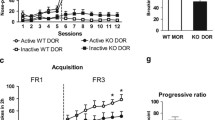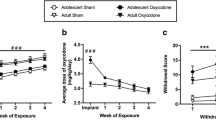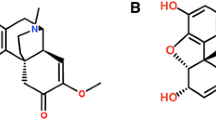Abstract
Rationale
Vulnerability to drug abuse disorders is determined not only by environmental but also by genetic factors. A body of evidence suggests that endogenous opioid peptide systems may influence rewarding effects of addictive substances, and thus, their individual expression levels may contribute to drug abuse liability.
Objectives
The aim of our study was to assess whether basal genotype-dependent brain expression of opioid propeptides genes can influence sensitivity to morphine reward.
Methods
Experiments were performed on inbred mouse strains C57BL/6J, DBA/2J, and SWR/J, which differ markedly in responses to morphine administration: DBA/2J and SWR/J show low and C57BL/6J high sensitivity to opioid reward. Proenkephalin (PENK) and prodynorphin (PDYN) gene expression was measured by in situ hybridization in brain regions implicated in addiction. The influence of the κ opioid receptor antagonist nor-binaltorphimine (nor-BNI), which attenuates effects of endogenous PDYN-derived peptides, on rewarding actions of morphine was studied using the conditioned place preference (CPP) paradigm.
Results
DBA/2J and SWR/J mice showed higher levels of PDYN and lower levels of PENK messenger RNA in the nucleus accumbens than the C57BL/6J strain. Pretreatment with nor-BNI enhanced morphine-induced CPP in the opioid-insensitive DBA/2J and SWR/J strains.
Conclusions
Our results demonstrate that inter-strain differences in PENK and PDYN genes expression in the nucleus accumbens parallel sensitivity of the selected mouse strains to rewarding effects of morphine. They suggest that high expression of PDYN may protect against drug abuse by limiting drug-produced reward, which may be due to dynorphin-mediated modulation of dopamine release in the nucleus accumbens.



Similar content being viewed by others
References
Bals-Kubik R, Herz A, Shippenberg TS (1989) Evidence that the aversive effects of opioid antagonists and kappa-agonists are centrally mediated. Psychopharmacology 98:203–206
Becker A, Grecksch G, Brodemann R, Kraus J, Peters B, Schroeder H, Thiemann W, Loh HH, Hollt V (2000) Morphine self-administration in mu-opioid receptor-deficient mice. Naunyn Schmiedebergs Arch Pharmacol 361:584–589
Belknap JK, Crabbe JC, Young ER (1993a) Voluntary consumption of ethanol in 15 inbred mouse strains. Psychopharmacology 112:503–510
Belknap JK, Crabbe JC, Riggan J, O’Toole LA (1993b) Voluntary consumption of morphine in 15 inbred mouse strains. Psychopharmacology 112:352–358
Belknap JK, Riggan J, Cross S, Young ER, Gallaher EJ, Crabbe JC (1998) Genetic determinants of morphine activity and thermal responses in 15 inbred mouse strains. Pharmacol Biochem Behav 59:353–360
Berrendero F, Kieffer BL, Maldonado R (2002) Attenuation of nicotine-induced antinociception, rewarding effects, and dependence in mu-opioid receptor knock-out mice. J Neurosci 22:10935–10940
Berrendero F, Mendizabal V, Robledo P, Galeote L, Bilkei-Gorzo A, Zimmer A, Maldonado R (2005) Nicotine-induced antinociception, rewarding effects, and physical dependence are decreased in mice lacking the preproenkephalin gene. J Neurosci 25:1103–1112
Broadbear JH, Negus SS, Butelman ER, de Costa BR, Woods JH (1994) Differential effects of systemically administered nor-binaltorphimine (nor-BNI) on kappa-opioid agonists in the mouse writhing assay. Psychopharmacology 115:311–319
Bruchas MR, Yang T, Schreiber S, Defino M, Kwan SC, Li S, Chavkin C (2007) Long-acting kappa opioid antagonists disrupt receptor signaling and produce noncompetitive effects by activating c-Jun N-terminal kinase. J Biol Chem 12:29803–29811
Bruchas MR, Land BB, Chavkin C (2009) the dynorphin/kappa opioid system as a modulator of stress-induced and pro-addictive behaviors. Brain Res. doi:10.1016/j.brainres.2009.08.062
Cabib S, Orsini C, Le Moal M, Piazza PV (2000) Abolition and reversal of strain differences in behavioral responses to drugs of abuse after a brief experience. Science 21:463–465
Calvino B, Lagowska J, Ben-Ari Y (1979) Morphine withdrawal syndrome: differential participation of structures located within the amygdaloid complex and striatum of the rat. Brain Res 177:19–34
Chavkin C, James IF, Goldstein A (1982) Dynorphin is a specific endogenous ligand of the kappa opioid receptor. Science 215:413–415
Chen AC, LaForge KS, Ho A, McHugh PF, Kellogg S, Bell K, Schluger RP, Leal SM, Kreek MJ (2002) Potentially functional polymorphism in the promoter region of prodynorphin gene may be associated with protection against cocaine dependence or abuse. Am J Med Genet 114:429–435
Civelli O, Douglass J, Goldstein A, Herbert E (1985) Sequence and expression of the rat prodynorphin gene. Proc Natl Acad Sci U S A 82:4291–4295
Clarke TK, Krause K, Li T, Schumann G (2009) An association of prodynorphin polymorphisms and opioid dependence in females in a Chinese population. Addict Biol 14:366–370
Corrigall WA, Coen KM, Adamson KL, Chow BL (1999) The mu opioid agonist DAMGO alters the intravenous self-administration of cocaine in rats: mechanisms in the ventral tegmental area. Psychopharmacology 141:428–435
Cunningham CL, Niehus DR, Malott DH, Prather LK (1992) Genetic differences in the rewarding and activating effects of morphine and ethanol. Psychopharmacology 107:385–393
Dahl JP, Weller AE, Kampman KM, Oslin DW, Lohoff FW, Ferraro TN, O’Brien CP, Berrettini WH (2005) Confirmation of the association between a polymorphism in the promoter region of the prodynorphin gene and cocaine dependence. Am J Med Genet B Neuropsychiatr Genet 139B:106–108
Delfs JM, Zhu Y, Druhan JP, Aston-Jones G (2000) Noradrenaline in the ventral forebrain is critical for opiate withdrawal-induced aversion. Nature 403:430–434
D’Este L, Casini A, Puglisi-Allegra S, Cabib S, Renda TG (2007) Comparative immunohistochemical study of the dopaminergic systems in two inbred mouse strains (C57BL/6J and DBA/2J). J Chem Neuroanat 33:67–74
de Waele JP, Gianoulakis C (1993) Effects of single and repeated exposures to ethanol on hypothalamic beta-endorphin and CRH release by the C57BL/6 and DBA/2 strains of mice. Neuroendocrinology 57:700–709
Di Chiara G, Imperato A (1988) Opposite effects of mu and kappa opiate agonists on dopamine release in the nucleus accumbens and in the dorsal caudate of freely moving rats. J Pharmacol Exp Ther 244:1067–1080
Di Chiara G, North RA (1992) Neurobiology of opiate abuse. Trends Pharmacol Sci 13:185–193
Doyle GA, Rebecca Sheng X, Lin SS, Press DM, Grice DE, Buono RJ, Ferraro TN, Berrettini WH (2007) Identification of three mouse mu-opioid receptor (MOR) gene (Oprm1) splice variants containing a newly identified alternatively spliced exon. Gene 388:135–147
Endoh T, Matsuura H, Tanaka C, Nagase H (1992) Nor-binaltorphimine: a potent and selective kappa-opioid receptor antagonist with long-lasting activity in vivo. Arch Int Pharmacodyn Ther 316:30–42
Fadda P, Scherma M, Fresu A, Collu M, Fratta W (2005) Dopamine and serotonin release in dorsal striatum and nucleus accumbens is differentially modulated by morphine in DBA/2J and C57BL/6J mice. Synapse 56:29–38
Froehlich JC, Zweifel M, Harts J, Lumeng L, Li T-K (1991) Importance of delta opioid receptors in maintaining high alcohol drinking. Psychopharmacology 103:467–472
Ghozland S, Matthes HW, Simonin F, Filliol D, Kieffer BL, Maldonado R (2002) Motivational effects of cannabinoids are mediated by mu-opioid and kappa-opioid receptors. J Neurosci 22:1146–1154
Glatt AR, Denton K, Boughter JD Jr (2009) Variation in nicotine consumption in inbred mice is not linked to orosensory ability. Chem Senses 34:27–35
Goeders NE, Lane JD, Smith JE (1984) Self-administration of methionine enkephalin into the nucleus accumbens. Pharmacol Biochem Behav 20:451–455
Goldman D, Oroszi G, Ducci F (2005) The genetics of addictions: uncovering the genes. Nat Rev Genet 6:521–532
Grabus SD, Martin BR, Brown SE, Damaj MI (2006) Nicotine place preference in the mouse: influences of prior handling, dose and strain and attenuation by nicotinic receptor antagonists. Psychopharmacology 184:456–463
Hall FS, Sora I, Uhl GR (2001) Ethanol consumption and reward are decreased in mu-opiate receptor knockout mice. Psychopharmacology 154:43–49
Hamlin AS, Buller KM, Day TA, Osborne PB (2004) Effect of naloxone-precipitated morphine withdrawal on c-fos expression in rat corticotropin-releasing hormone neurons in the paraventricular hypothalamus and extended amygdala. Neurosci Lett 362:39–43
Heimer L, Alheid GF (1991) Piecing together the puzzle of basal forebrain anatomy. Adv Exp Med Biol 295:1–42 Review
Horan P, Taylor J, Yamamura HI, Porreca F (1992) Extremely long-lasting antagonistic actions of nor-binaltorphimine (nor-BNI) in the mouse tail-flick test. J Pharmacol Exp Ther 260:1237–1243
Houdi AA, Pierzchala K, Marson L, Palkovits M, Van Loon GR (1991) Nicotine-induced alteration in Tyr-Gly-Gly and Met-enkephalin in discrete brain nuclei reflects altered enkephalin neuron activity. Peptides 12:161–166
Jamensky NT, Gianoulakis C (1997) Content of dynorphins and kappa-opioid receptors in distinct brain regions of C57BL/6 and DBA/2 mice. Alcohol Clin Exp Res 21:1455–1464
Jamensky NT, Gianoulakis C (1999) Comparison of the proopiomelanocortin and proenkephalin opioid peptide systems in brain regions of the alcohol-preferring C57BL/6 and alcohol-avoiding DBA/2 mice. Alcohol 18:177–187
Johnson PI, Stellar JR (1994) Comparison of delta opiate receptor agonist induced reward and motor effects between the ventral pallidum and dorsal striatum. Neuropharmacology 33:1171–1182
Johnson PI, Stellar JR, Paul AD (1993) Regional reward differences within the ventral pallidum are revealed by microinjections of a mu opiate receptor agonist. Neuropharmacology 32:1305–1314
Kest B, Palmese CA, Hopkins E, Adler M, Juni A, Mogil JS (2002) Naloxone-precipitated withdrawal jumping in 11 inbred mouse strains: evidence for common genetic mechanisms in acute and chronic morphine physical dependence. Neuroscience 115:463–469
Koob GF, Le Moal M (1997) Drug abuse: hedonic homeostatic dysregulation. Science 278:52–58
Koob GF, Le Moal M (2001) Drug addiction, dysregulation of reward, and allostasis. Neuropsychopharmacology 24:97–129
Krishnan-Sarin S, Jing SL, Kurtz DL, Zweifel M, Portoghese PS, Li TK, Froehlich JC (1995) The delta opioid receptor antagonist naltrindole attenuates both alcohol and saccharin intake in rats selectively bred for alcohol preference. Psychopharmacology 120:177–185
Le Guen S, Gestreau C, Besson JM (2001) Sensitivity to naloxone of the behavioral signs of morphine withdrawal and c-Fos expression in the rat CNS: a quantitative dose-response analysis. J Comp Neurol 433:272–296
Lessov CN, Swan GE, Ring HZ, Khroyan TV, Lerman C (2004) Genetics and drug use as a complex phenotype. Subst Use Misuse 39:1515–1569
Matthes HW, Maldonado R, Simonin F, Valverde O, Slowe S, Kitchen I, Befort K, Dierich A, Le Meur M, Dollé P, Tzavara E, Hanoune J, Roques BP, Kieffer BL (1996) Loss of morphine-induced analgesia, reward effect and withdrawal symptoms in mice lacking the mu-opioid-receptor gene. Nature 383:819–823
McBride WJ, Murphy JM, Ikemoto S (1999) Localization of brain reinforcement mechanisms: intracranial self-administration and intracranial place-conditioning studies. Behav Brain Res 101:129–152
McLaughlin JP, Marton-Popovici M, Chavkin C (2003) Kappa opioid receptor antagonism and prodynorphin gene disruption block stress-induced behavioral responses. J Neurosci 2:5674–5683
Meliska CJ, Bartke A, McGlacken G, Jensen RA (1995) Ethanol, nicotine, amphetamine, and aspartame consumption and preferences in C57BL/6 and DBA/2 mice. Pharmacol Biochem Behav 50:619–626
Mendez M, Barbosa IG, Perez JM, Cupo A, Oikawa I (2005) Ethanol differentially stimulates the in vivo release of met-enkephalin from the rat nucleus accumbens. ISN, J Neurochem 94:(Supl 12)94
Murphy NP, Lam HA, Maidment NT (2001) A comparison of morphine-induced locomotor activity and mesolimbic dopamine release in C57BL6, 129Sv and DBA2 mice. J Neurochem 79:626–635
Nomura A, Ujike H, Tanaka Y, Otani K, Morita Y, Kishimoto M, Morio A, Harano M, Inada T, Yamada M, Komiyama T, Sekine Y, Iwata N, Sora I, Iyo M, Ozaki N, Kuroda S (2006) Genetic variant of prodynorphin gene is risk factor for methamphetamine dependence. Neurosci Lett 400:158–162
Nylander I, Hyytia P, Forsander O, Terenius L (1994) Differences between alcohol-preferring (AA) and alcohol-avoiding (ANA) rats in the prodynorphin and proenkephalin systems. Alcohol Clin Exp Res 18:1272–1279
Olive MF, Maidment NT (1998) Opioid regulation of pallidal enkephalin release: bimodal effects of locally administered mu and delta opioid agonists in freely moving rats. J Pharmacol Exp Ther 28:1310–1316
Olive MF, Bertolucci M, Evans CJ, Maidment NT (1995) Microdialysis reveals a morphine-induced increase in pallidal opioid peptide release. Neuroreport 6:1093–1096
Olive MF, Koenig HN, Nannini MA, Hodge CW (2001) Stimulation of endorphin neurotransmission in the nucleus accumbens by ethanol, cocaine, and amphetamine. J Neurosci 21:RC184
Orsini C, Bonito-Oliva A, Conversi D, Cabib S (2005) Susceptibility to conditioned place preference induced by addictive drugs in mice of the C57BL/6 and DBA/2 inbred strains. Psychopharmacology 181:327–336
Pan YX (2005) Diversity and complexity of the mu opioid receptor gene: alternative pre-mRNA splicing and promoters. DNA Cell Biol 24:736–750
Phillips AG, Le Piane FG (1982) Reward produced by microinjection of (D-Ala), Met-enkephalinamide into the ventral tegmental area. Behav Brain Res 5:225–229
Ploj K, Roman E, Gustavsson L, Nylander I (2000) Basal levels and alcohol-induced changes in nociceptin/orphanin FQ, dynorphin, and enkephalin levels in C57BL/6J mice. Brain Res Bull 53:219–226
Redila VA, Chavkin C (2008) Stress-induced reinstatement of cocaine seeking is mediated by the kappa opioid system. Psychopharmacology 200:59–70
Roberts AJ, McDonald JS, Heyser CJ, Kieffer BL, Matthes HW, Koob GF, Gold LH (2000) mu-Opioid receptor knockout mice do not self-administer alcohol. J Pharmacol Exp Ther 293:1002–1008
Schroeder JA, Hummel M, Simpson AD, Sheikh R, Soderman AR, Unterwald EM (2007) A role for mu opioid receptors in cocaine-induced activity, sensitization, and reward in the rat. Psychopharmacology 195:265–272
Semenova S, Kuzmin A, Zvartau E (1995) Strain differences in the analgesic and reinforcing action of morphine in mice. Pharmacol Biochem Behav 50:17–21
Skoubis PD, Maidment NT (2003) Blockade of ventral pallidal opioid receptors induces a conditioned place aversion and attenuates acquisition of cocaine place preference in the rat. Neuroscience 119:241–249
Skoubis PD, Matthes HW, Walwyn WM, Kieffer BL, Maidment NT (2001) Naloxone fails to produce conditioned place aversion in mu-opioid receptor knock-out mice. Neuroscience 106:757–763
Skoubis PD, Lam HA, Shoblock J, Narayanan S, Maidment NT (2005) Endogenous enkephalins, not endorphins, modulate basal hedonic state in mice. Eur J Neurosci 21:1379–1384
Solecki W, Turek A, Kubik J, Przewlocki R (2009) Motivational effects of opiates in conditioned place preference and aversion paradigm-a study in three inbred strains of mice. Psychopharmacology 207:245–255
Sora I, Elmer G, Funada M, Pieper J, Li XF, Hall FS, Uhl GR (2001) Mu opiate receptor gene dose effects on different morphine actions: evidence for differential in vivo mu receptor reserve. Neuropsychopharmacology 25:41–54
Spanagel R, Herz A, Shippenberg TS (1990) The effects of opioid peptides on dopamine release in the nucleus accumbens: an in vivo microdialysis study. J Neurochem 55:1734–1740
Spanagel R, Herz A, Shippenberg TS (1992) Opposing tonically active endogenous opioid systems modulate the mesolimbic dopaminergic pathway. Proc Natl Acad Sci U S A 89:2046–2050
Spanagel R, Almeida OF, Shippenberg TS (1994) Evidence that nor-binaltorphimine can function as an antagonist at multiple opioid receptor subtypes. Eur J Pharmacol 264(2):157–162
Stolerman IP, Naylor C, Elmer GI, Goldberg SR (1999) Discrimination and self-administration of nicotine by inbred strains of mice. Psychopharmacology 141:297–306
Takemori AE, Ho BY, Naeseth JS, Portoghese PS (1988) Nor-binaltorphimine, a highly selective kappa-opioid antagonist in analgesic and receptor binding assays. J Pharmacol Exp Ther 246:255–258
Tzschentke TM (2007) Measuring reward with the conditioned place preference (CPP) paradigm: update of the last decade. Addict Biol 12(3–4):227–462
Veinante P, Stoeckel ME, Lasbennes F, Freund-Mercier MJ (2003) c-Fos and peptide immunoreactivities in the central extended amygdala of morphine-dependent rats after naloxone-precipitated withdrawal. Eur J Neurosci 18:1295–305
Welzl H, Kuhn G, Huston JP (1989) Self-administration of small amounts of morphine through glass micropipettes into the ventral tegmental area of the rat. Neuropharmacology 28:1017–1023
Williams TJ, LaForge KS, Gordon D, Bart G, Kellogg S, Ott J, Kreek MJ (2007) Prodynorphin gene promoter repeat associated with cocaine/alcohol codependence. Addict Biol 12:496–502
Xi ZX, Fuller SA, Stein EA (1998) Dopamine release in the nucleus accumbens during heroin self-administration is modulated by kappa opioid receptors: an in vivo fast-cyclic voltammetry study. J Pharmacol Exp Ther 284:151–161
Xuei X, Dick D, Flury-Wetherill L, Tian HJ, Agrawal A, Bierut L, Goate A, Bucholz K, Schuckit M, Nurnberger J Jr, Tischfield J, Kuperman S, Porjesz B, Begleiter H, Foroud T, Edenberg HJ (2006) Association of the kappa-opioid system with alcohol dependence. Mol Psychiatry 11:1016–1024
Yoshikawa K, Williams C, Sabol SL (1984) Rat brain preproenkephalin mRNA. cDNA cloning, primary structure, and distribution in the central nervous system. J Biol Chem 259:14301–14308
Young WS 3rd, Bonner TI, Brann MR (1986) Mesencephalic dopamine neurons regulate the expression of neuropeptide mRNAs in the rat forebrain. Proc Natl Acad Sci U S A 83:9827–9831
Yuferov V, Ji F, Nielsen DA, Levran O, Ho A, Morgello S, Shi R, Ott J, Kreek MJ (2009) A functional haplotype implicated in vulnerability to develop cocaine dependence is associated with reduced PDYN expression in human brain. Neuropsychopharmacology 34:1185–1197
Zachariou V, Bolanos CA, Selley DE, Theobald D, Cassidy MP, Kelz MB, Shaw-Lutchman T, Berton O, Sim-Selley LJ, Dileone RJ, Kumar A, Nestler EJ (2006) An essential role for DeltaFosB in the nucleus accumbens in morphine action. Nat Neurosci 9:205–211
Zahm DS, Zaborszky L, Alones VE, Heimer L (1985) Evidence for the coexistence of glutamate decarboxylase and Met-enkephalin immunoreactivities in axon terminals of rat ventral pallidum. Brain Res 325:317–321
Zimprich A, Kraus J, Wöltje M, Mayer P, Rauch E, Höllt V (2000) An allelic variation in the human prodynorphin gene promoter alters stimulus-induced expression. J Neurochem 74:472–477
Zubieta JK, Ketter TA, Bueller JA, Xu Y, Kilbourn MR, Young EA, Koeppe RA (2003) Regulation of human affective responses by anterior cingulate and limbic mu-opioid neurotransmission. Arch Gen Psychiatry 60:1145–1153
Zurawski G, Benedik M, Kamb BJ, Abrams JS, Zurawski SM, Lee FD (1986) Activation of mouse T-helper cells induces abundant preproenkephalin mRNA synthesis. Science 232:772–775
Acknowledgments
This work was supported by statutory funds from Institute of Pharmacology Polish Academy of Sciences, the EU grant LSHM-CT-2004-005166 GENADDICT, and the Polish Ministry of Science and Higher Education subsidiary grant 936/6.PR UE/2009/7 to EU grant LSHM-CT-2004-005166 GENADDICT.
Author information
Authors and Affiliations
Corresponding author
Rights and permissions
About this article
Cite this article
Gieryk, A., Ziolkowska, B., Solecki, W. et al. Forebrain PENK and PDYN gene expression levels in three inbred strains of mice and their relationship to genotype-dependent morphine reward sensitivity. Psychopharmacology 208, 291–300 (2010). https://doi.org/10.1007/s00213-009-1730-1
Received:
Accepted:
Published:
Issue Date:
DOI: https://doi.org/10.1007/s00213-009-1730-1




